
Kongjian Yu úttörő szerepet játszott Kína „szivacsváros” koncepciójának kialakításában – kevesebb beton és több zöldterület, a csapadékvíz kiaknázása, az ellene való küzdelem helyett. A jó példát több metropolisz is követi szerte a világon.
A szivacsvárosokkal kapcsolatos munkájáért Yu nemrég elnyerte a Kulturális Táj Alapítvány Oberlander-díját.
Az Ön városa fel van készülve a klímaváltozás hatásaira?
A csapadékvíz kezelésének klasszikus módszere, hogy a lehető leggyorsabban kivezetik a vizet a városból a csatornák segítségével, megbukott. Ahogy a légkör melegszik, egyre több csapadékot képes megtartani, ami egyre hevesebb viharokat szül, az özönvízszerű esők pedig túlterhelik azt a nyikorgó infrastruktúrát, aminek el kellene vezetnie a vizet. Városainkat egy 100, 200, 300 évvel ezelőtti éghajlatra tervezték és építették, de ez az éghajlat már nem létezik.
A várostervezés, városfejlesztés új, Kínában bevezetett stratégiája az, hogy mindent lassítsunk le. Kínának 2013 óta van nemzeti stratégiája, melynek célja, hogy növekvő metropoliszait szivacsvárosokká alakítsa át, amelyek megtartják a csapadékvizet ahelyett, hogy gyorsan megszabadulnának tőle. Ha a mérnökök képesek lelassítani a víz levezetését és lehetővé teszik, hogy az a talajba szivárogjon – esőkertek, szórt talajok (Spreading ground), vízáteresztő burkolatok és városi vizes élőhelyek használatával -, ezek a lehetőségek egyidejűleg képesek csökkenteni a villámárvizek hatásait és feltölteni a mélyebben fekvő víztartó rétegeket is. Ez pedig egyre fontosabb lesz, ahogy a bolygó melegszik és az aszályok fokozódnak: a szivacsvárosok célja, hogy vizet gyűjtsenek az esős napokon, hogy legyen tartalék az aszályos napokra.
„Amikor esik az eső, a lehető legtöbb csapadékot megtartjuk” – mondja Kongjian Yu, a koncepció kidolgozója, a pekingi Turenscape tervezőiroda alapítója. „Lelassítjuk a víz elfolyását, és hagyjuk, hogy a föld befogadja azt. A szivacsvárosból alkalmazkodó város lesz, egy rugalmas vízgazdálkodású, porózus táj.”
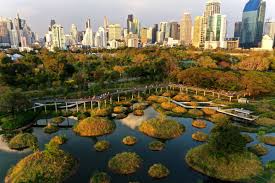
Egy nemrégiben készült tanulmány szerint az Egyesült Államok városai naponta több milliárd liter vizet szívhatnának fel, ha követnék Kína példáját és felgyorsítanák a szivacsprojekteket.
„A szivacsváros egy azonnali megoldás, amely képes a városokat az éghajlatváltozáshoz, a hőséghez, az árvizekhez és az aszályhoz alkalmazkodóvá tenni” – mondja Yu.
Az egyik dolog, ami ezt a koncepciót olyan erőteljessé teszi, az az, hogy különböző léptékekben lehet megvalósítani. Los Angelesben például vannak olyan, több száz méter átmérőjű nyílt területek, ahol a víz be tud szivárogni a víztartó rétegbe, de az út szélén lévő vékony sávokat is szivaccsá lehet tenni, zöld területek kialakításával.
A víz értékes. Ha képesek vagyunk visszatartani a csapadékot a kertjeinkben, akkor nem kell a fákat, növényeket öntöznünk, mert a víz helyben marad – a kincs itt van, a lábunk alatt. Ez a szemlélet pedig személyes, egyéni és közösségi szinten is működik.
Az iparosított mérnöki megoldások globális szinten egyszerűen összezavarták az egész vízrendszert. Mindenhol csökkent a talajvíz, és ez végül hatalmas problémákat okoz – nagyobb problémát, mint a villámárvizek pusztítása.
A problémát holisztikusan kell megoldani, és a szivacsváros egy természetalapú, holisztikus megoldás, ami olcsó, kis léptékben is megvalósítható. Regionális, nagyobb léptékben persze nagyobb, összetettebb tervre van szükségünk, hogy lássuk, hol lehet nagyobb teret adni a víznek. Ennek az összetettebb tervnek megvannak a holisztikus előnyei: A víztározók feltöltődésével a környezet is szebb lesz, ami növeli az ingatlanok értékét is, de támogatja a biológiai sokféleséget is.
Mi a helyzet a másik nagyvárosi problémával, a hőséggel?
Ha van növényzet, akkor azonnal drámaian csökken a hőmérséklet, ami egy városban akár életeket is menthet. Ez megoldható egy zöldtetővel, zöldfallal, vagy bármilyen zöld felülettel – mindenhol lehet zöld, ez pedig nemcsak a fényvisszaverődést, hanem a párolgás (a transpiráció és evaporáció) miatt a hőmérsékletet is csökkenti.
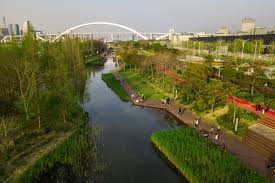
A vízmegtartásnak a városi kertek tekintetében is mérhető haszna van. Ha a városi kertek nagyobb mennyiségben termelhetnek élelmiszert helyben, azzal csökkenthető a szállítási kibocsátást. Az akvakultúrával bármilyen növényt lehet termeszteni, amelyet kombinálni lehet a vízgazdálkodással. Ez a megközelítés nemcsak egy új szemléletmódot, de egy új esztétikát is teremt. Más szemmel nézhetünk a parkjainkra, melyek így “vadabbá”, emellett produktívvá válnak, ahova visszatér a természet, a madarak, a beporzók is.
Kínában a szivacsvárosok kialakítása a városok növekedésével együtt valósult meg. Felmerülhet a kérdés, hogy egy már meglévő nagyvárosi infrastruktúra hogyan alakítható át vízmegtartóvá. Yu szerint azonban ez csak hozzáállás kérdése. Akár a Central Park is szivacs-parkká alakítható. Los Angeles egy sík város, ahol rengeteg kertet öntöznek – ezeket a kerteket egyszerűen szivaccsá kell változtatni.
Hosszú ideig azt tartottuk civilizált megoldásnak, ha minél gyorsabban elvezettük a vizet. A csapadékvizet és a szennyvizeket is. Egyik oldalon elszivattyúzzuk a szennyvizünket, így lesz a város tiszta, higiénikus. A másik oldalon bevezetjük a vizet a városba, és gyönyörű, öntözött pázsitot hozunk létre. Ezt nevezzük civilizációnak. Ez azonban egy teljesen téves és fenntarthatatlan elképzelés.
A hagyományos csapadékvíz-kezelés, amit mi szürke infrastruktúrának nevezünk – beton, csövek és szivattyúk, amelyeket arra terveztek, hogy a lehető leggyorsabban elvezessék a vizet – az éghajlatváltozás miatt megbukott vagy meg fog bukni. Ha újraépítjük ezt az infrastruktúrát, akkor csak rontunk a helyzeten, vagy ismét kudarcot vallunk.
Ha azonban a zöld alternatívához folyamodunk, nemcsak pénzt takarítunk meg, de a hatás is közvetlenebb lesz. A szivacsváros alapvetően a természet ingyen nyújtott szolgáltatásait használja. Ilyen egyszerű.
A probléma azonban éppen abból adódik, hogy ingyen van. Senki sem akar befektetni, mert senki sem tud pénzt keresni vele. Ezért az üzleti modellt, a politikát és a filozófiát is meg kell változtatni.
Szöveg és képek forrása: wired.com


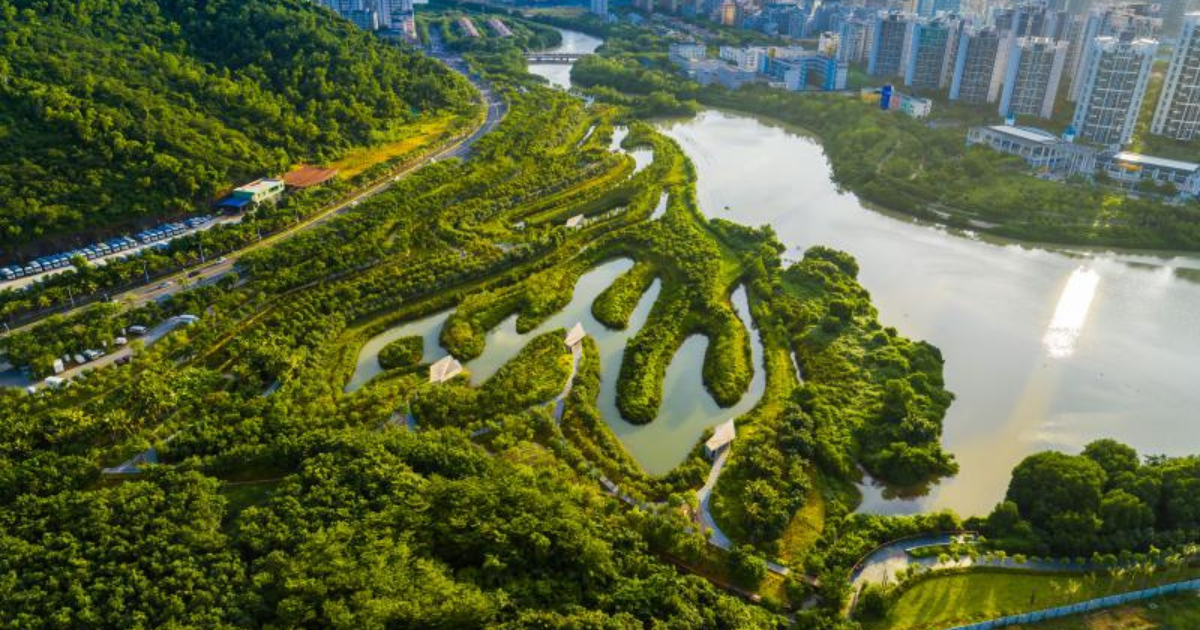
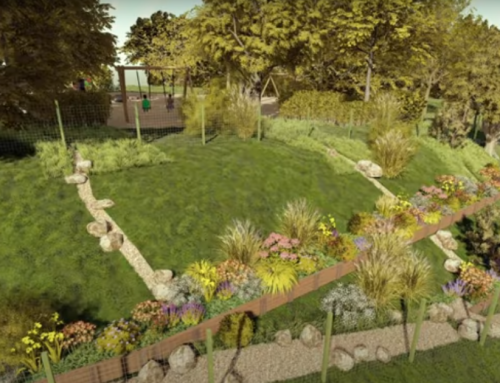

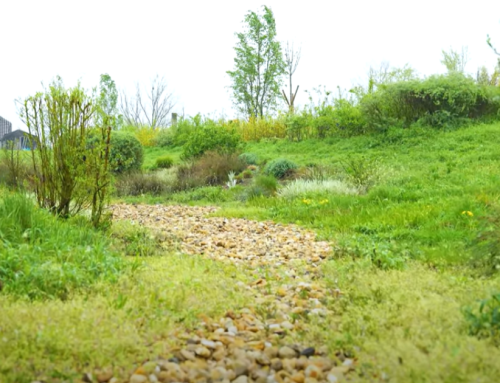

Hagyj üzenetet